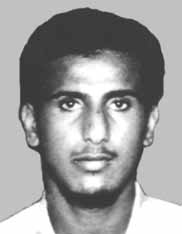د قضیې مطالعه
Usama al Kini was reportedly one of the ‘highest-ranking terrorists’ the US killed or captured during the war on terror. He was a senior militant with al Qaeda in Pakistan though originally from Kenya. He was killed in a US drone strike – the last of George W. Bush’s presidency – in South Waziristan, Pakistan, on January 2 2009.
Little is known about the early life of Kini – whose real name was Fahid Mohammed Ally Msalam – except his date and place of birth which were published by the US Treasury. According to the US Kini was born on February 19 1976 in Mombasa, Kenya, and held Kenyan nationality. He had previously ‘worked as a clothing vendor’, according to the FBI.
Kini was pursued by US counter-terrorism officials for a decade before his death and appeared on an FBI list released in October 2001, among its 22 most wanted terrorists. There was reportedly a reward on Kini’s head of $5 million. The FBI listing said he was between 5,6” and 5’8”, of medium build and sometimes had ‘a light beard or moustache’.
In 1998, Kini was indicted by a US federal grand jury for his role as an alleged ‘central planner’ in attacks on American embassies in Kenya and Tanzania. He later appeared on several US Treasury lists as specially designated individuals subject to foreign assets control measures. One American official told the New York Times Kini ‘was active in training terrorists in Africa in the 1990s’.
Following the attacks of September 11, Kini reportedly became al Qaeda’s operations chief in Afghanistan’s Zabul province and ‘oversaw operations to recruit and train operatives and raise money in the Horn of Africa’, according to a US official quoted by the New York Times. ‘He later shifted among Afghanistan, Pakistan and East Africa, planning suicide missions, training operatives and raising money,’ US officials told the Washington Post.
Kini reportedly became al Qaeda’s director of operations in Pakistan in 2007. US officials accused him of involvement in at least seven suicide bomb attacks in this capacity. Among these attacks are the attempted assassination of former Pakistani Prime Minister Benazir Bhutto in Karachi in October 2007, which killed at least 139 people, and the bombing of the Marriott Hotel in Islamabad in September 2008, which killed 54.
He reportedly earned the local nickname of Asmaray Khan in Pakistan – Asmaray means ‘The Beast‘ in Pashtun. He was notorious, well known far beyond the tribal regions of Pakistan. His name featured several times as a ‘high value target’, in information reported by the Washington Post concerning individuals targeted by CIA drone strikes in Pakistan in 2008. One attack, on August 12, featuring Kini’s name was later shown by data belonging to a local tribal administration to have been a ‘NATO/ANA [Afghan National Army] attack’.
Kini was wrongly reported to have died in a suspected US drone strike on a car in Kari Kot, Wana, South Waziristan on January 1 2009. One eyewitness told the Bureau that at least three people were killed after one missile hit the car before a second hit them as they tried to flee the scene.
‘One of the guys [hit by the strike] was famous for his terror,’ the eyewitness said. ‘He was the local commander. He wasn’t a Pakistani, he was an Arab [sic] but his local name as Asmaray Khan [Kini].’
Kini was actually killed when two missiles struck an abandoned girls’ school – thought to have been used as a Pakistani Taliban base – in Madin, South Waziristan, on January 2 2009. According to Joby Warrick, Washington Post journalist and author of The Triple Agent: The al-Qaeda Mole Who Infiltrated the CIA, the strike was personally authorised by then CIA director Michael Hayden, who demanded that the drone operator substitute missiles for a bunker-busting 500lb bomb in order to ensure Kini’s death.
A counter-terrorism official told the Washington Post a week after the strike that Kini was ‘one of the 10 highest-ranking terrorists the CIA has ever killed or captured’.
Picture from: Rewards for Justice
سرچینې او یادونې
Pakistan Interior Ministry statistics (The News); CIA officials (Washington Post); US officials (New York Times)
اخځلیکونه
